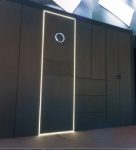
RFID Wardrobe-New Application of Smart Wardrobe
[ad_1]

The startup ThreadRobe, based in Virginia, plans to automate the way people store and manage clothes. Its new automated wardrobe combines passive ultra-high frequency (UHF) RFID technology and a mobile application App. With this RFID wardrobe, users can store clean clothes in boxes, and then identify each piece of clothing through RFID, and the wardrobe will automatically hang it up. When the customer needs to take it, the RFID wardrobe will be automatically steam ironed and provided to the user. At the same time, the RFID closet supporting App allows customers to view the clothes hanging in the closet and issue corresponding instructions.
Kristy Schultz, vice president of marketing for ThreadRobe, said: “We spent a year communicating with consumers to determine what is most important to consumers.” She said that our research found that users “the biggest pain is folding and Put down your clothes”. So the ThreadRobe system is designed to take over this problem from users. Once the clean clothes are put in the box, the robot built in the wardrobe will pick up and hang each item, and then automatically provide the clothes to the individual when needed.
Many technologies, such as RFID, are applied to RFID wardrobes. First of all, users must apply RFID tags to each clothing store. RFID tags include clothing such as socks, underwear, swimwear, shirts, casual pants, jeans and suits.
Clothing enters the RFID wardrobe:
An individual user uses an app on his smartphone to enter information about each piece of clothing, including taking photos, so that the system knows its color. Photos are also used to identify clothing in the App. Matt Powell, the founder and CEO of ThreadRobe, said that it takes about 30 seconds to identify each piece of clothing. Then, the user stands within the reading range of the RFID reader antenna holding the clothing with the RFID information in it (the RFID antenna is installed inside the wardrobe, but is designed to be read outside), so that the RFID tag ID can be read Is linked to the garment. ThreadRobe uses various UHF RFID readers and antennas.
When clothes with RFID tags are placed in the RFID wardrobe box, 30 pieces of clothes can be loaded at a time. The device uses the rubber hook on the robot arm to pick up each piece of clothing. In this process, the RFID tag of the clothes will be close to the second built-in RFID antenna in the closet, so that the clothes can be identified. The RFID wardrobe software will select a storage location suitable for the size of the piece of clothing, and the hook will move to that location. Then, the dress remains directly on that hook until it is needed to be taken out.
The clothing is taken out of the RFID wardrobe:
When customers need to take out their clothes, they can use the ThreadRobe app. Application-based data is transmitted to the wardrobe, and then the clothes connected to the hook (already linked to its RFID number) are released at the selected time, and they are steam ironed at a preset level before being released, providing To the user. The clothing is not folded because it needs steam ironing. At the same time, it should be wrinkle-free and ready to be worn.
RFID wardrobe information system:
“The other aspect of the system is the digital wardrobe,” Powell said. The RFID Wardrobe App stores information about the clothes entered into the system when the user is marked, and the things hanging in the closet (anything not in the closet can be presumed to be being worn or washed). The user enters enough detailed information about each piece of clothing so that the ThreadRobe application can know how each piece of clothing is worn (for example, business or gym), and save a record of the time and frequency the user retrieves from the wardrobe.
Users can use the RFID Wardrobe App to choose a week’s worth of clothing for themselves or their children, or pack and travel when not at home. They can choose clothing from the RFID wardrobe App, match them, and then choose the clothing to be provided when packing. The RFID wardrobe App can also be used when shopping to determine which items in the user’s wardrobe may match the clothing he or she plans to buy.
This technology currently uses UHF RFID tags and requires a sufficiently robust washing cycle. The company hopes to use near field communication (NFC) and UHF RFID dual tags that can be placed on each piece of clothing. With the NFC reader built into the user’s smart phone, the user can automatically enter the tag into the system without asking outside the wardrobe during the process. But UHF technology is still necessary to ensure that the reading distance is long enough because it is processed in the closet to identify each piece of clothing. “We are interested in tags with dual interfaces, and we have a great demand for this,” Powell said.
RFID wardrobes are available in two sizes: compact, which can hold up to 100 pieces, and spacious, which can store up to 200 pieces of clothes. According to ThreadRobe, the average person owns 185 pieces of clothing, including underwear, socks and swimwear.
Schultz said the ThreadRobe app also allows users to track items that are not stored in the closet (such as shoes, handbags, belts and other accessories) and integrate these items into clothing or packing lists. Their goal is to make the RFID wardrobe APP a complete digital wardrobe for users, “no matter where the clothes are placed.
[ad_2]






